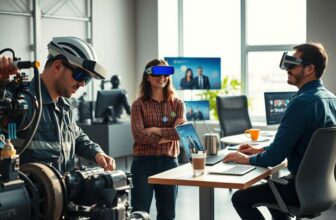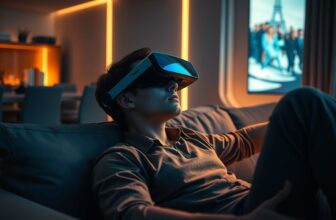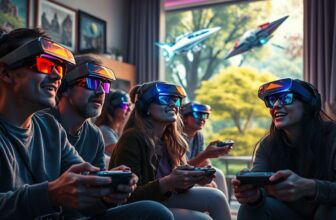Introduction
Mixed Reality (MR) glasses represent a groundbreaking technological frontier, transforming how we interact with digital and physical worlds. These advanced wearable devices are rapidly evolving, promising to revolutionize industries from healthcare to entertainment by overlaying interactive digital information onto our real-world environment. According to recent market research, the global MR glasses market is projected to grow exponentially, highlighting the immense potential of what are MR glasses in reshaping our technological landscape.
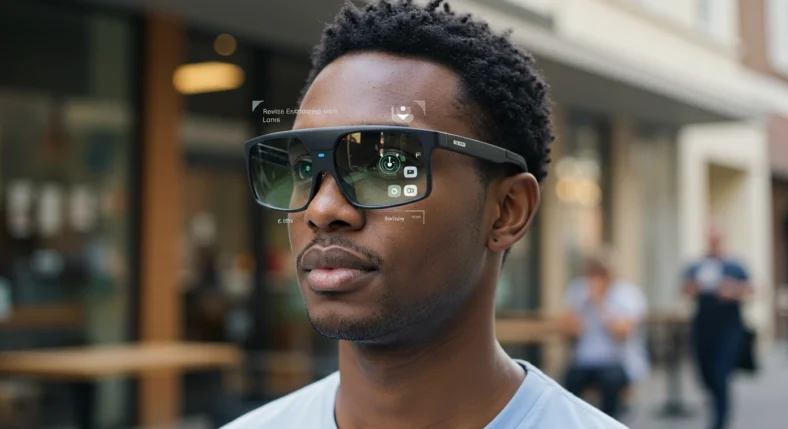
Understanding the Basics of MR Glasses
The Core Technology Behind MR Glasses
What are MR glasses truly revolutionizing in the world of technology? At their essence, these sophisticated devices represent a quantum leap in human-computer interaction. Unlike traditional computing interfaces, MR glasses transform how we perceive and interact with digital information by creating a seamless bridge between physical and virtual environments.
The fundamental architecture of MR glasses revolves around several critical technological components. High-resolution microdisplays project digital content directly into the user’s field of vision, while advanced optical systems ensure crisp, clear imagery that integrates naturally with the surrounding environment. Powerful onboard processors work in real-time to render complex 3D graphics, process sensor data, and maintain instantaneous responsiveness.
Key technological breakthroughs include:
- Transparent display technologies that allow simultaneous viewing of digital and physical worlds
- Advanced spatial mapping sensors that understand environmental context
- Real-time computational processing capable of rendering complex mixed-reality experiences
- Precise eye-tracking and gesture recognition systems
MR glasses represent a sophisticated evolution beyond traditional AR and VR technologies, creating a dynamic, interactive hybrid space.
How MR Glasses Differ from AR and VR
Mixed Reality (MR) glasses represent a sophisticated evolution beyond traditional Augmented Reality (AR) and Virtual Reality (VR) technologies. While AR typically overlays simple digital information onto the real world and VR completely replaces the physical environment, MR glasses create a dynamic, interactive hybrid space where digital and physical elements coexist and interact in real-time.
The primary differentiator lies in interaction complexity. AR might display a static navigation arrow, VR might transport you to a completely simulated environment, but MR glasses enable users to manipulate digital objects as if they were physical entities. Imagine moving a virtual 3D model of a building design on an actual conference table or playing a holographic chess game where pieces interact with real-world surfaces.
Comparative characteristics include:
- AR: Surface-level digital information overlay
- VR: Complete digital environment replacement
- MR: Interactive digital-physical integration
What are MR Glasses in Terms of Component Technology
Modern MR glasses represent a complex ecosystem of interconnected technologies. Depth-sensing cameras function as the primary environmental understanding mechanism, continuously mapping physical spaces and tracking user movements with millimeter-level precision. Advanced optics, including waveguide or projection technologies, enable seamless digital content rendering.
Computational power stands at the heart of MR glasses’ capabilities. High-performance processors, often utilizing specialized neural processing units, handle complex tasks like real-time 3D rendering, environmental understanding, and predictive user interaction modeling. These aren’t merely display devices but sophisticated mobile computing platforms.
Critical technological components include:
- Depth-sensing RGB-D cameras
- Inertial measurement units (IMUs)
- High-resolution microdisplays
- Edge computing processors
- Low-latency wireless communication modules
Evolution of MR Glass Design
The journey of MR glasses mirrors the rapid technological advancement of personal computing devices. Early prototypes were bulky, limited in computational power, and offered minimal user interaction. Current generation devices demonstrate remarkable miniaturization, with designs approaching the form factor of conventional eyewear.
Ergonomic considerations have driven significant design innovations. Modern MR glasses prioritize user comfort through lightweight materials, balanced weight distribution, and adaptable frame designs. Battery technology improvements have extended operational times, making these devices increasingly practical for extended professional and personal use.
Technological Innovations Driving MR Glasses
Advanced Optical Systems in What are MR Glasses
The optical core of MR glasses represents a technological marvel that fundamentally transforms how we perceive digital information. Cutting-edge waveguide technologies and holographic display methods enable unprecedented visual fidelity, projecting high-resolution digital content that seamlessly blends with the physical environment.
Micro-LED and laser-based projection technologies have revolutionized display capabilities. These advanced optical systems utilize intricate light-guiding mechanisms that can project images with exceptional brightness, color accuracy, and minimal power consumption. Manufacturers like Microsoft (HoloLens) and Magic Leap have pioneered optical architectures that create wide field-of-view experiences with remarkable depth and clarity.
Key optical innovations include:
- Holographic waveguide displays
- Pupil-forming optical engines
- Dynamic focus technologies
- Multi-layer display architectures
Spatial Awareness and Tracking Technologies
Spatial understanding represents the neural network of MR glasses’ interaction capabilities. Advanced depth-sensing cameras, including time-of-flight (ToF) sensors and structured light technologies, create real-time 3D environmental maps with millimeter-level precision. These systems enable MR glasses to understand physical spaces, detect surfaces, and intelligently place digital content.
Artificial intelligence algorithms play a critical role in spatial tracking. Machine learning models continuously analyze sensor data, predicting user intentions, understanding contextual environments, and enabling responsive digital interactions. These sophisticated tracking mechanisms allow digital objects to interact realistically with physical surfaces, creating truly immersive mixed-reality experiences.
Spatial tracking capabilities include:
- Environmental mesh generation
- Real-time surface detection
- Occlusion handling
- Predictive interaction modeling
Computational Power and Processing Capabilities
The computational architecture of MR glasses represents a quantum leap in mobile computing design. Specialized system-on-chip (SoC) processors, often incorporating neural processing units (NPUs), handle complex computational tasks with unprecedented efficiency. These powerful onboard computers process multiple sensor streams, render sophisticated 3D graphics, and maintain sub-10-millisecond latency.
Edge computing principles drive MR glasses’ processing capabilities. By distributing computational tasks between onboard processors and cloud infrastructure, these devices can perform complex calculations while maintaining responsive user experiences. Custom silicon designs from companies like Qualcomm and Apple have dramatically improved computational efficiency and graphics rendering capabilities.
Processing technology highlights:
- Dedicated neural processing units
- Low-power, high-performance SoC architectures
- Heterogeneous computing approaches
- Real-time graphics rendering capabilities
Connectivity and Ecosystem Integration
Modern MR glasses transcend standalone device limitations through sophisticated connectivity architectures. 5G and Wi-Fi 6E technologies enable high-bandwidth, low-latency connections that support seamless cloud integration, real-time collaborative experiences, and sophisticated data streaming capabilities.
Ecosystem integration represents a critical innovation frontier. MR glasses now function as comprehensive computing platforms, seamlessly connecting with smartphones, cloud services, IoT devices, and enterprise software solutions. APIs and developer frameworks allow custom application development, expanding potential use cases across professional and consumer domains.
Connectivity innovation dimensions:
- 5G and Wi-Fi 6E support
- Cloud computing integration
- Cross-platform development frameworks
- Secure data transmission protocols
Future-Proofing Through Modular Design
Emerging MR glasses incorporate modular design philosophies that facilitate ongoing technological upgrades. Detachable computational modules, upgradeable optical components, and standardized integration interfaces allow manufacturers and users to incrementally enhance device capabilities without complete hardware replacement.
This approach democratizes technological advancement, creating more sustainable and adaptable mixed-reality platforms. By designing flexible architectural frameworks, manufacturers can rapidly iterate on specific technological components while maintaining compatibility with existing ecosystems.
- Modular design advantages:
- Enhanced user customization
- Incremental hardware upgrades
- Reduced electronic waste
- Faster technological iteration
These sophisticated devices promise to reshape how we work, learn, and interact with the world around us.
Practical Applications of MR Glasses
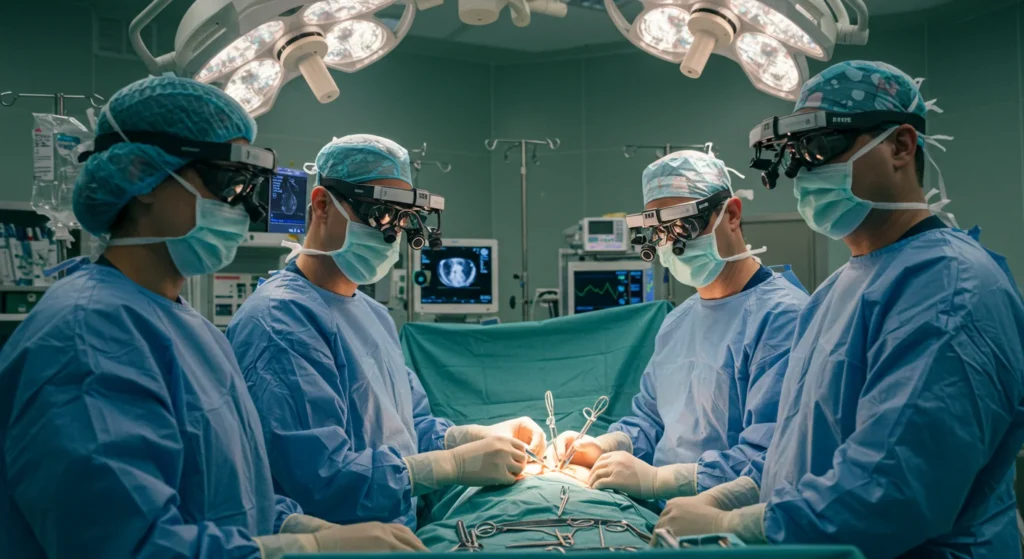
Professional and Industrial Use Cases for What are MR Glasses
Mixed Reality (MR) glasses are revolutionizing professional workflows across multiple industries by providing unprecedented visualization and interaction capabilities. In engineering and design, these devices enable professionals to manipulate complex 3D models in real-time, overlaying digital prototypes directly onto physical environments. Architects can walk through building designs before construction, examining structural details and spatial relationships with remarkable precision.
Manufacturing sectors have embraced MR glasses as transformative tools for maintenance, training, and quality control. Technicians can access real-time diagnostic information, overlay repair instructions, and receive remote expert guidance while keeping their hands free. Companies like Boeing have reported significant productivity improvements, with some processes becoming up to 40% more efficient through MR glass interventions.
Key professional application domains include:
- Aerospace engineering visualization
- Complex equipment maintenance
- Remote expert collaboration
- Precision manufacturing design
- Industrial training and simulation
Educational and Training Environments
MR glasses are redefining educational experiences by creating immersive, interactive learning environments that transcend traditional pedagogical methods. Students can explore complex scientific concepts through three-dimensional visualizations, manipulating molecular structures, exploring astronomical phenomena, or dissecting virtual biological systems with unprecedented interactivity.
Professional training programs have discovered exceptional value in MR technologies. Medical students can practice surgical procedures in risk-free virtual environments, engineering apprentices can interact with complex machinery simulations, and technical professionals can receive hands-on training without physical equipment constraints. These immersive experiences dramatically accelerate learning curves and improve knowledge retention.
Educational transformation highlights:
- Interactive 3D scientific visualizations
- Risk-free professional skill development
- Adaptive learning experiences
- Global knowledge accessibility
- Personalized training simulations
Entertainment and Gaming Experiences
Entertainment represents a frontier where MR glasses unlock entirely new interaction paradigms. Unlike traditional gaming experiences, MR enables players to blend digital gameplay with physical environments, creating unprecedented interactive narratives. Imagine battling virtual monsters in your living room or solving complex puzzle games that dynamically integrate with your surrounding space.
Major gaming and entertainment companies are investing heavily in MR technologies. Titles are being developed specifically to leverage spatial computing capabilities, creating experiences that respond to physical environments and player movements. Location-based entertainment venues are exploring MR glasses as platforms for shared, immersive group experiences that transcend traditional entertainment boundaries.
Gaming and entertainment innovations include:
- Environmental adaptive gameplay
- Mixed-reality narrative experiences
- Multiplayer spatial interactions
- Location-based entertainment
- Interactive storytelling platforms
Healthcare and Medical Innovations
Medical professionals are leveraging MR glasses to revolutionize diagnostic, surgical, and treatment processes. Surgeons can access real-time patient data, overlay medical imaging directly onto a patient’s body during procedures, and receive augmented guidance from remote specialists. These technologies enable more precise interventions and reduce potential human error.
Medical education has been dramatically transformed by MR technologies. Students can now practice complex procedures in fully immersive, realistic simulations. Patient education has also improved, with doctors able to explain medical conditions using interactive 3D visualizations that enhance understanding and patient engagement.
Medical application domains:
- Surgical planning and intervention
- Medical training simulations
- Remote surgical consultation
- Patient data visualization
- Rehabilitation and therapy support
The MR glasses market is poised for exponential growth, with market research projecting a potential valuation exceeding $30 billion by 2027.
Challenges and Future Developments
Current Technical Limitations of What are MR Glasses
Mixed Reality (MR) glasses continue to grapple with several critical technological challenges that prevent widespread adoption. Battery life remains a significant constraint, with most current models offering only 2-4 hours of continuous use. Computational complexity demands substantial energy resources, creating a persistent trade-off between performance and operational duration.
Optical technologies present another substantial challenge. Achieving a wide field of view while maintaining high-resolution image quality and minimal visual distortion requires breakthrough innovations. Current MR glasses struggle to provide a truly seamless visual experience, with issues like limited peripheral visibility and occasional rendering artifacts that disrupt user immersion.
Key technical limitations include:
- Limited battery performance
- Computational heat generation
- Optical system constraints
- Weight and ergonomic challenges
- Signal processing latency
Emerging Design Innovations
Researchers and manufacturers are pioneering breakthrough design approaches to address existing MR glass limitations. Nano-engineering and advanced materials science are enabling the development of ultra-lightweight, energy-efficient computational components. Innovations in micro-LED and holographic display technologies promise dramatically improved visual fidelity and power consumption.
Modular design philosophies are emerging as a solution to technological obsolescence. Future MR glasses may feature upgradeable computational cores, interchangeable optical modules, and adaptive form factors that can be customized for specific professional or consumer use cases. This approach democratizes technological advancement and reduces electronic waste.
Design innovation focus areas:
- Lightweight computational architectures
- Advanced thermal management
- Adaptive optical systems
- Sustainable hardware ecosystems
- Flexible form factor designs
Potential Market Expansion Strategies
The MR glasses market is poised for exponential growth, with market research projecting a potential valuation exceeding $30 billion by 2027. Decreasing component costs and improved manufacturing processes are making these technologies increasingly accessible to both professional and consumer markets. Enterprise adoption is expected to drive initial market penetration.
Strategic market expansion will likely follow a bifurcated approach, targeting professional users in healthcare, engineering, and education while simultaneously developing consumer-friendly designs. Manufacturers are investing heavily in creating versatile platforms that can seamlessly transition between professional and personal use cases.
Market expansion dimensions:
- Enterprise technology adoption
- Consumer accessibility
- Cross-industry application development
- Competitive pricing strategies
- Global technological infrastructure
Ethical and Privacy Considerations
The integration of MR technologies raises profound ethical questions about data privacy, personal boundaries, and digital interactions. These devices capture extensive environmental and personal data, creating potential surveillance and privacy risks. Robust regulatory frameworks and advanced privacy-preserving technologies will be critical to responsible MR glass deployment.
Societal implications extend beyond individual privacy concerns. MR glasses have the potential to fundamentally alter social interactions, cognitive processes, and human perception of reality. Researchers and ethicists are actively exploring the long-term psychological and social impacts of persistent mixed-reality experiences.
- Ethical consideration domains:
- Regulatory compliance frameworks
- Data collection and consent
- Psychological impact assessment
- Social interaction transformation
- Digital privacy protection
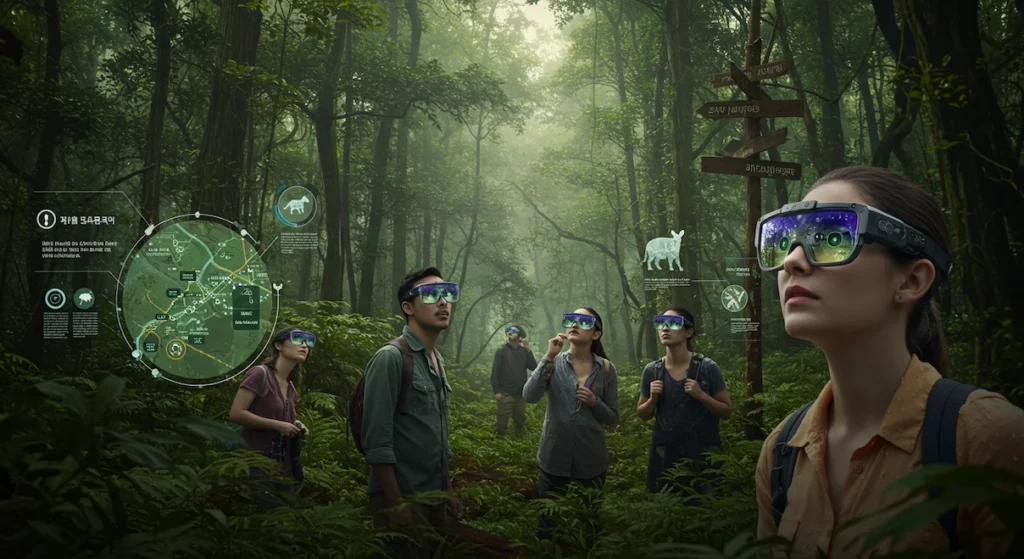
Consumer Considerations for MR Glasses
Selecting the Right MR Glasses for Your Needs
What are MR glasses in the context of personal technology selection? They represent sophisticated computing platforms requiring careful evaluation. Consumers must prioritize specific use cases, ranging from professional applications to entertainment and personal productivity.
Key selection criteria include computational performance, battery longevity, and ecosystem compatibility. Professional users might prioritize processing power and specialized software integration, while consumers may focus on user-friendly interfaces and multimedia capabilities.
Critical selection factors:
- Intended primary use
- Computational specifications
- Battery performance
- Ergonomic design
- Software ecosystem support
Cost and Investment Considerations
MR glasses currently represent a significant financial investment, with professional-grade devices ranging from $1,500 to $3,500. Enterprise solutions and specialized medical applications often justify higher price points through demonstrable productivity gains and workflow transformations.
Market dynamics suggest progressive price reduction as manufacturing scales and component technologies mature. Early adopters can expect increasingly sophisticated devices at more accessible price points in the coming years.
Investment perspective highlights:
- Varied price ranges by use case
- Potential long-term value generation
- Technology depreciation considerations
- Enterprise vs. consumer pricing models
User Experience and Learning Curve
Technological sophistication demands intentional user adaptation. MR glasses introduce complex interaction paradigms that diverge from traditional computing interfaces. Users must develop spatial computing skills, including gesture control, environmental interaction, and multi-dimensional information processing.
Manufacturers are developing more intuitive onboarding experiences, incorporating adaptive tutorials and progressive skill-building interfaces. Machine learning algorithms increasingly anticipate user intentions, reducing initial complexity.
Learning experience dimensions:
- Gesture and spatial interaction training
- Contextual user interface adaptation
- Personalized interaction modeling
- Skill progression frameworks
Maintenance and Support Ecosystem
Robust support infrastructure is crucial for MR glass investments. Leading manufacturers provide comprehensive warranty programs, regular firmware updates, and dedicated technical support channels. Enterprise solutions often include advanced service level agreements (SLAs) with rapid response times.
Software ecosystem maintenance involves continuous platform updates, security patches, and feature enhancements. Users should evaluate manufacturers’ historical commitment to long-term device support and technological evolution.
Support considerations:
- Repair and replacement policies
- Warranty coverage options
- Firmware update frequency
- Technical support accessibility
Frequently Asked Questions
Q1: Are MR glasses the same as AR glasses?
No, MR glasses offer more interactive and dynamic digital integration compared to traditional AR glasses.
Q2: How expensive are MR glasses?
Prices vary widely, ranging from $1,000 to $3,500 depending on features and intended use.
Q3: Can MR glasses be used for professional work?
Absolutely, many industries are adopting MR glasses for training, design, medical, and engineering applications.
Q4: Do MR glasses require special software?
Most MR glasses come with proprietary software and can integrate with various professional and consumer platforms.
Q5: How long do MR glasses’ batteries typically last?
Current models offer 2-4 hours of continuous use, with ongoing improvements in battery technology.
Q6: Are MR glasses comfortable to wear?
Modern designs focus on ergonomics, with lightweight materials and adjustable components for improved comfort.
Conclusion
What are MR glasses? They represent a transformative technology bridging digital and physical realities. As innovation continues, these sophisticated devices promise to reshape how we work, learn, and interact with the world around us. Professionals and consumers alike should stay informed about this rapidly evolving technological frontier.



